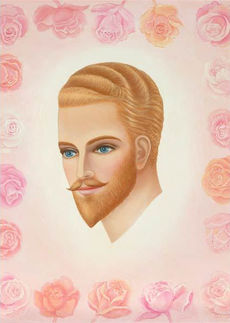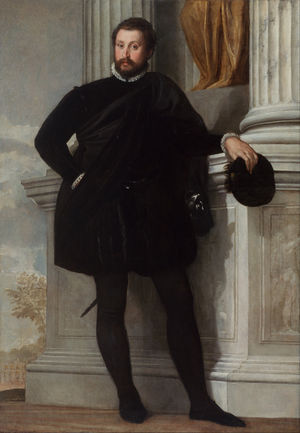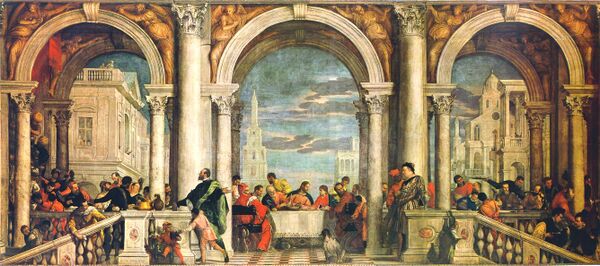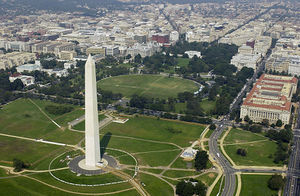Páll Feneyingur

Paul the Venetian is chohan of the third ray of divine love. He is hierarch of the Château de Liberté, his retreat on the etheric plane over southern France on the Rhône River.
Paul sponsors the ascended master culture for this age and works with all who desire to bring that culture forth on behalf of mankind. The culture of the ascended masters is the keystone in the pyramid of the golden age; for they have said that it is through culture that mankind will respond to spiritual truths and the teachings of the Great White Brotherhood.
Embodiments
Head of cultural affairs on Atlantis
In the days of Atlantis, Paul served in the government as the head of cultural affairs. Before the continent sank, he established a focus of the liberty flame in Peru, which gave impetus to the culture, beauty and wealth of the Incan civilization.
Artist in the Incan civilization
He embodied in the Incan empire as an artist who used paints that did not fade (a mastery that he brought back in his final embodiment). Thanks to the tremendous momentum that he drew forth, the Inca civilization flourished.
Master of architecture in Egypt
Later, he was embodied in Egypt as a master of esoteric architecture and worked closely with El Morya, then a master mason, at the time of the building of the pyramids.

Paolo Veronese
► Main article: Paolo Veronese
His final embodiment was as Paolo Veronese, one of the major artists of the 16th-century Venetian school. Born Paolo Cagliari in Verona, Italy, in 1528, the artist’s early training gained him renown at a young age as a talented painter. At twenty-five, he was welcomed to Venice as a master of his art. The palatial splendor of this city, its pearls and silks from the East, its elegant tapestries and brocades enriched his work, which rose to the heights of decorative excellence.
Veronese’s ornamentations soon led to dramatic experiments with new colors. In his quest for beauty, he freed himself from the dull browns and grays of his predecessors by modeling in full light, making his already graceful figures iridescent and nearly transparent. He developed glistening pastel hues of azure, coral, pearl, lilac and lemon yellow that startled and fascinated his patrons. He loved deep, bold contrasting colors, and he combined shades never used before—ruby and rich velvety green, pink and emerald, aquamarine and violet.
As if to stress that true beauty endures forever, Veronese searched for and discovered a technique of pigment preparation that is unsurpassed in preserving paint. His magnificent colors still radiate brilliantly today, compared with the fading ceiling of the Sistine Chapel and even Tiepolo’s now-deteriorating frescoes painted two centuries later.
Veronese was a spiritual revolutionary who waged battle against the forces of anti-life in the arts. He saw beauty as the most powerful catalyst for enlightenment, and he endowed the figures of Jesus, the apostles and saints with lifelike expressions. By associating them with easily identifiable places and things, he put them within the reach of the common people. The master transcended the traditionally flat, lifeless and grim aspects of medieval art; his biblical scenes and historical subjects, festivals and pageants were refreshingly executed with joy and sweeping grandeur.

He illustrated the steps of initiation on the path of Christhood and was prolific in painting the martyrdom of the saints. His most impressive work is the vast Marriage at Cana, which hangs in the Louvre. His other paintings included the Temptation of Saint Anthony, the Coronation of the Virgin, the Deposition from the Cross, Supper at Emmaus, the Holy Family and the Raising of Lazarus—each one of these an important initiation in Christhood.

On one occasion he was summoned before the tribunal of the Inquisition under suspicion of heresy for the “irreverences” in his painting of the Last Supper, which included in it a dwarf, a parrot, guards in German armour, dogs and a jester. Veronese staunchly defended the artist’s right to freedom of imagination. The tribunal found a solution by suggesting that the painting be renamed Feast in the House of Levi.
In 1588, he contracted a fever and, after a few days of illness, died on April 9. His brother and sons had him buried in S. Sebastiano, where a bust was placed above his grave. He made his ascension from the Château de Liberté on April 19, 1588.
Here at the Château, prior to his ascension, he had begun the most majestic of his works, known as “The Holy Trinity.” The heavenly Father is portrayed by a majestic figure, the likeness of Jesus depicts the Son, and an impressive white dove with a nine-foot wingspan denotes the Holy Spirit. The canvas has the unprecedented distinction of conveying the vibrations of both dimensions of activity—the earthly and the heavenly—in which Paolo was so interested, for the canvas was completed after his ascension. Beneath the painting of “The Holy Trinity,” Paul has inscribed in gold letters: “Perfect Love Casteth out Fear.”
His mission today
Paul the Venetian is a majestic being of some six feet, five inches in height. He is fair of countenance with deep blue eyes and golden, wavy hair. He is usually garbed in raiment of emerald-green velvet. Since he is a native of the planet Venus, where the inhabitants are masters of the Flame and therefore radiate harmony and divine love, Paul’s natural heritage is beauty and grace, diplomacy and tact. His voice is melodious and kind, bringing comfort and peace to all who come in contact with his Presence.
The ascended master Paul the Venetian is a great teacher of the path of love. His devotion is to beauty, the perfection of the soul through compassion, patience, understanding, self-discipline and the development of the intuitive and creative faculties of the heart by the alchemy of self-sacrifice, selflessness and surrender. He initiates the heart chakra, and he trains us in the gift of the discerning of spirits—discerning good and evil, light and shadow and the delicate nuances of all of our creations of beauty. Discernment is a real inner sensitivity to one another.
Retreats
► Main article: Château de Liberté
► Main article: Temple of the Sun
Paul’s retreat, the Château de Liberté, has a physical counterpart in a château now owned by a private French family. At the etheric level, the retreat contains classrooms with paintings and artwork of every kind from all ages and races and cultures, as well as workshops for musicians, writers, sculptors and students of voice. Here the masters introduce new techniques in every field of art.
Currently he is holding classes in the Temple of the Sun, the etheric retreat of the Goddess of Liberty over Manhattan. This is the etheric retreat of Paul’s spiritual Mother, who is the Goddess of Liberty—the cosmic being behind the statue, so named for her complete identification with the God consciousness of liberty. It was she who first enshrined the liberty flame on earth and, just prior to the sinking of Atlantis, transported it from her then-physical Temple of the Sun to the Château de Liberté.
Transfer of the Liberty Flame from his retreat
It was the Goddess of Liberty who inspired the idea of the Statue of Liberty as a gift of the people of France to the people of the United States, which was dedicated on Bedloe’s Island October 28, 1886. A symbol of their friendship and more, it was the spanning of the arc of liberty from the Château de Liberté back to the Temple of the Sun with the intent that the descendants of Atlantis reembodied at both her East and West gates (at France and the United States) would hold high her torch until Liberty’s culture should once again appear in a golden age founded upon the balanced and expanded threefold flame in the hearts of the freedom-loving people of these sister nations.

Seventy-six years later, in a dictation given in Washington, D.C., September 30, 1962, the ascended master K-17 announced the bestowal of another gift from France to America, this time from Paul the Venetian:
There has been held a beautiful and wonderful session at Chananda’s retreat in India, and a decision was made on the part of beloved Paul the Venetian whereby there was transferred from his retreat in France this day, at the hour of eleven o’clock your time, the full pulsation of the great liberty flame.
This flame was permanently placed within the forcefield of the Washington Monument; and the pulsations of the liberty flame are intended to grace the heart of America as a gift from the Brotherhood and from the heart of beloved Paul the Venetian....
It is given as a treasure from the heart of France, from the spiritual government of France to the spiritual government of America.... The liberty flame is a gift of greater magnitude than the former gift of France, the Statue of Liberty, as a tribute to that great being, the Goddess of Liberty. It is incomparable, for the flame itself shall penetrate the structure of the monument, rising high into the atmosphere above it. And all who visit there shall become, even without knowing it, infused by the pulsations of the liberty flame within the heart of America.
Studying with Paul the Venetian

Embodied mankind who serve in the arts attend the retreats of Paul the Venetian for instruction in all of the arts, and through their service, they learn to balance and expand the threefold flame within the heart. Paul explains that the purpose of art is to enhance the love of Christ always.
One who studied at Paul the Venetian’s retreat was Norman Rockwell, American painter and illustrator (1894–1978). Paul speaks of instructing him:
I remember when Norman Rockwell came to me at inner levels to study in my etheric retreat. And I remember as I counseled him to show the Christ in the American people, in everyday scenes of humor, humility, wonder, togetherness, heroism. And all these have been treasured, remembered and valued highly because something of the spirit of the Christ image that is become an image of America came through his work.
A unique artist, one devoted to the inherent qualities and identity of the individual. As his perception of the Christ was, so was his painting the capturing of unique moments. You might examine that work to find in each painting what is the glimmer, however great or faint, of some aspect of the individual reaching for the Higher Self.[1]
The beloved master Paul has promised an important initiation to those who come knocking at the door of his retreat in southern France, ready for a greater increment of the love flame:
I will take you by the hand and show you my castle. I will show you the works of art that have been brought forth by chelas unascended and ascended. And we will go through many rooms, and lastly I will take you to the room where there is that frame that hangs. In some cases it will be an empty frame; in some cases it will have a canvas in it. It will be your frame, the frame of your identity waiting for you to bring forth the genius of your soul. And when you see that frame, if it is empty, you will want to fill it.
And so I will take you to that place, “The Atelier,” where you can work with other artisans who are learning the art of living love by the discipline of the hand and the discipline of expression so that you can draw the image of your own Christ-perfection. And when it is the best that you have to offer, it will be placed in your frame.
And when you come again before that frame after many months of purging and self-purification, you will say undoubtedly, “Beloved Paul, may I have another opportunity to express my Christhood, to draw the image of myself? For I have perceived a new aspect of that image, and I would like to have this, my best offering, now placed in my frame.” And, of course, you will have the opportunity.[2]
The purpose of art
The ascended master Paul the Venetian says:
I AM Paul the Venetian. I paint on canvas on the ethers. I etch in crystal, I sculpt, I mold the clay. I fashion all things physical and many substances not known to you in the higher octaves. To what purpose? To the purpose of showing forth an evermore revealing and exquisite image of the Christ—the Christ appearing in children, in people from every walk of life....
Is it any wonder that we deplore the chaotic and abstract art that has no point of unity? It also portrays a certain barrenness and absence of that point of light in the individual. One can see anarchy by an absence of dimension—an absence of harmony or focalization in modern art.
Modern art enters the subconscious. Accordingly, whether or not the artist is influenced by marijuana or other substances, art portrayed in fabric design, wall coverings, clothing style becomes a matrix capable or incapable of carrying some measure of Christly proportion. When the peoples’ art and sense of art flounders, then the images of Christ recede.
It is rare to find a work of art that is come from the etheric octave in this period.... Where will your leaders learn to deal with the invaders of the minds of the nations? They will learn from the etheric schoolrooms and cities and retreats. How will they get there if they do not contain the crystal that becomes the magnet and a star to follow when the soul goes forth from the body in the hours of sleep?
Unless angels and devotees of light accompany them, they will have no new idea, no means of resolution. Without internal harmony that is the direct child of perfect love, there is no resolution to international terror or the threat of nuclear war. And while abortion itself seems to me the supreme act of anti-art, it does beget the callousness that year-by-year has a lessening sensitivity to the art of angels and the art of God who fashioned the perfect image out of which you were sculpted in clay.
Thus, beloved ones, it is necessary in the very midst of the most tense international circumstances to retreat into the contemplation of the divine beauty and the music of the spheres, to remember that the building blocks of creation are sound and that sound forms a pattern that is a divine harmony and that this divine harmony can be portrayed in architecture, in life, in everyday utensils such as pottery. The things you use and you surround yourself with become a focus for the flow of attention.
Art is not a subject so often dwelt upon in our discourses, for there are such pressing needs—pressing needs of the hour for the victory for Saint Germain. I bring my ingredient of love in this hour as an offering to the Christ Child, to the one and the beloved whom I have so longed to paint in the ultimate sense and have done so to the best of my ability in the etheric octave.[3]
His twin flame
Paul the Venetian’s twin flame is the ascended lady master Ruth Hawkins, the Goddess of Beauty. She ascended in 1995 at the age of eighty-eight and serves with him at the Temple of the Sun.
You may pray to Paul the Venetian to assist you in developing your heart chakra and the threefold flame of the heart and to bring forth the image of the Christ consciousness in your life. Ask him to sponsor the true art of the Aquarian age and to overshadow artists of all kinds in bringing forth the consciousness of the Christ.
Paul the Venetian’s keynote is “I Love You Truly,” by Carrie Jacobs-Bond.
See also
For more information
For more information about the teachings of Paul the Venetian, see the chapters about him in Mark L. Prophet and Elizabeth Clare Prophet, Lords of the Seven Rays.
Sources
Mark L. Prophet and Elizabeth Clare Prophet, The Masters and Their Retreats, s.v. “Paul the Venetian.”
- ↑ Paul the Venetian, “The Art of Love,” Pearls of Wisdom, vol. 27, no. 3, January 15, 1984.
- ↑ Mark L. Prophet and Elizabeth Clare Prophet, Lords of the Seven Rays, book 2, pp. 112–13.
- ↑ Paul the Venetian, “The Art of Love,” Pearls of Wisdom, vol. 27, no. 3, January 15, 1984.
